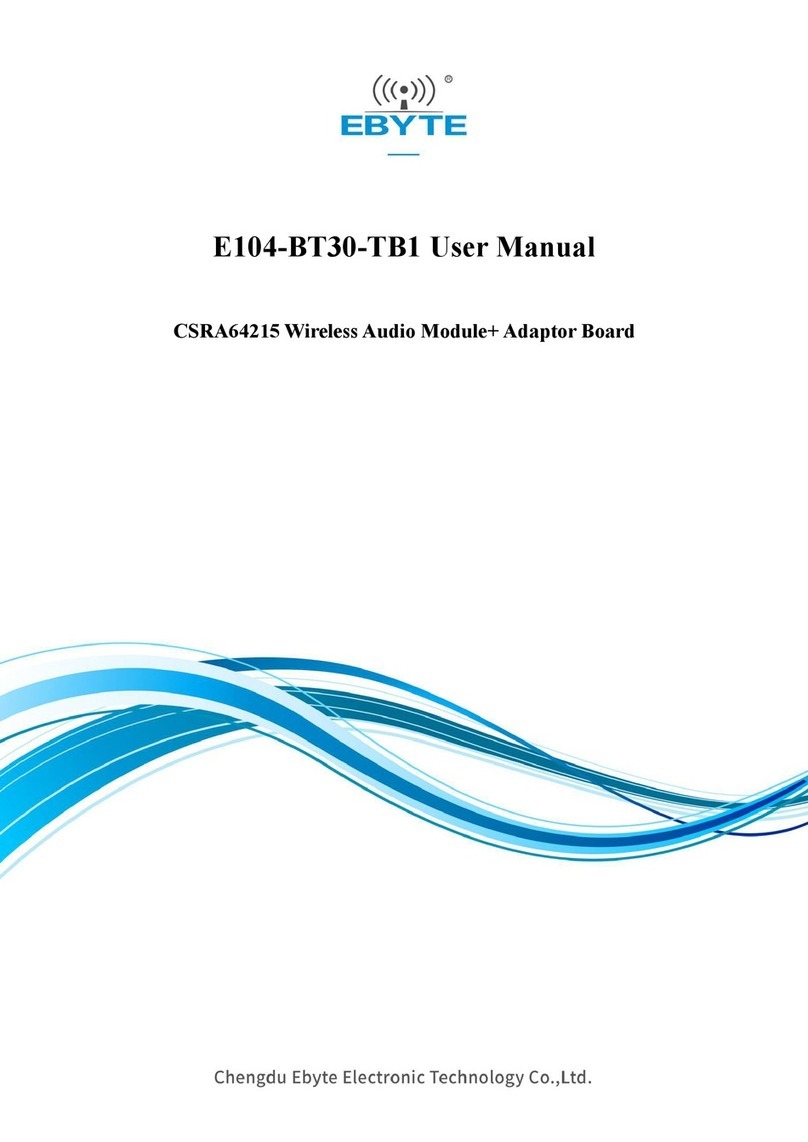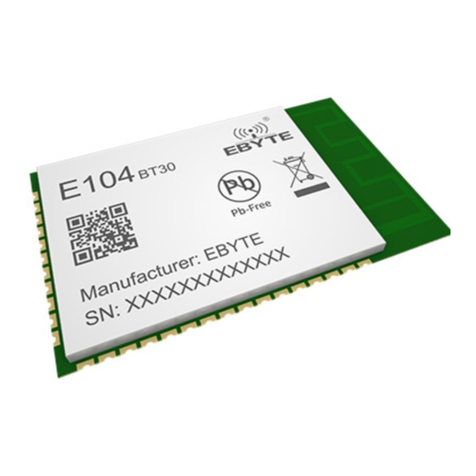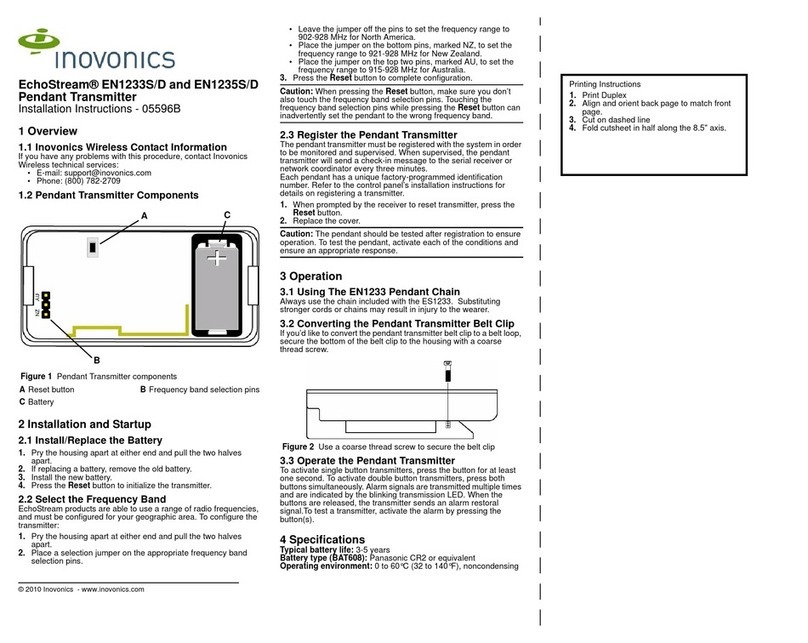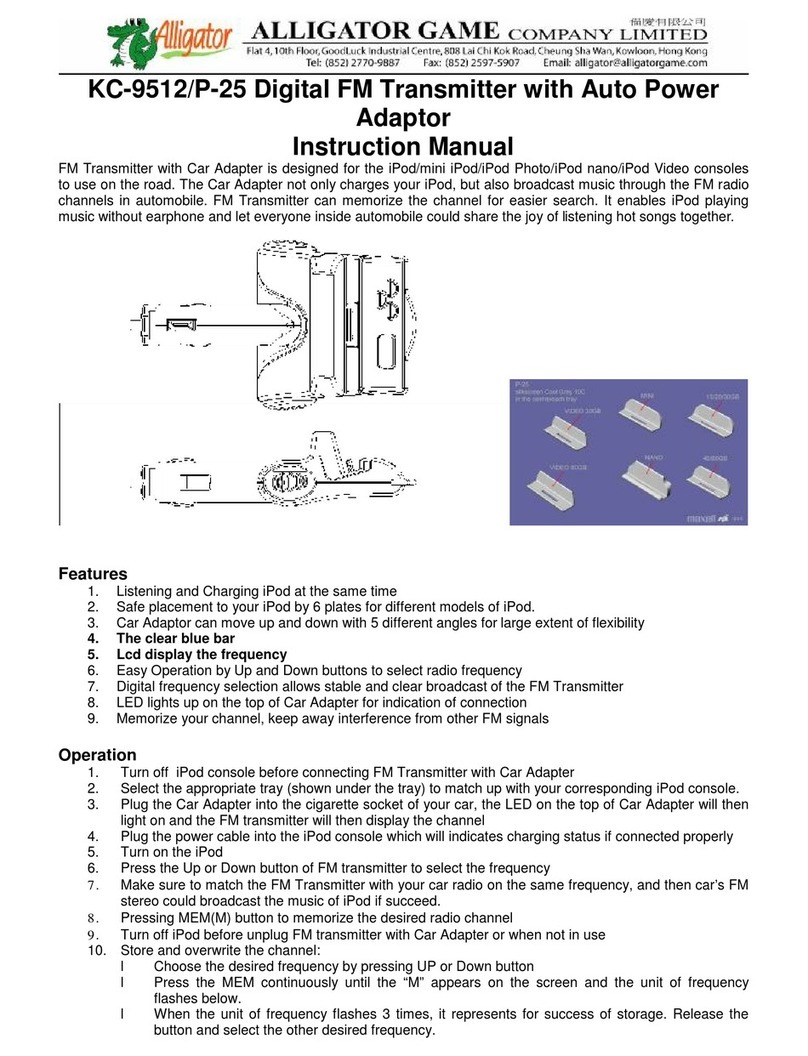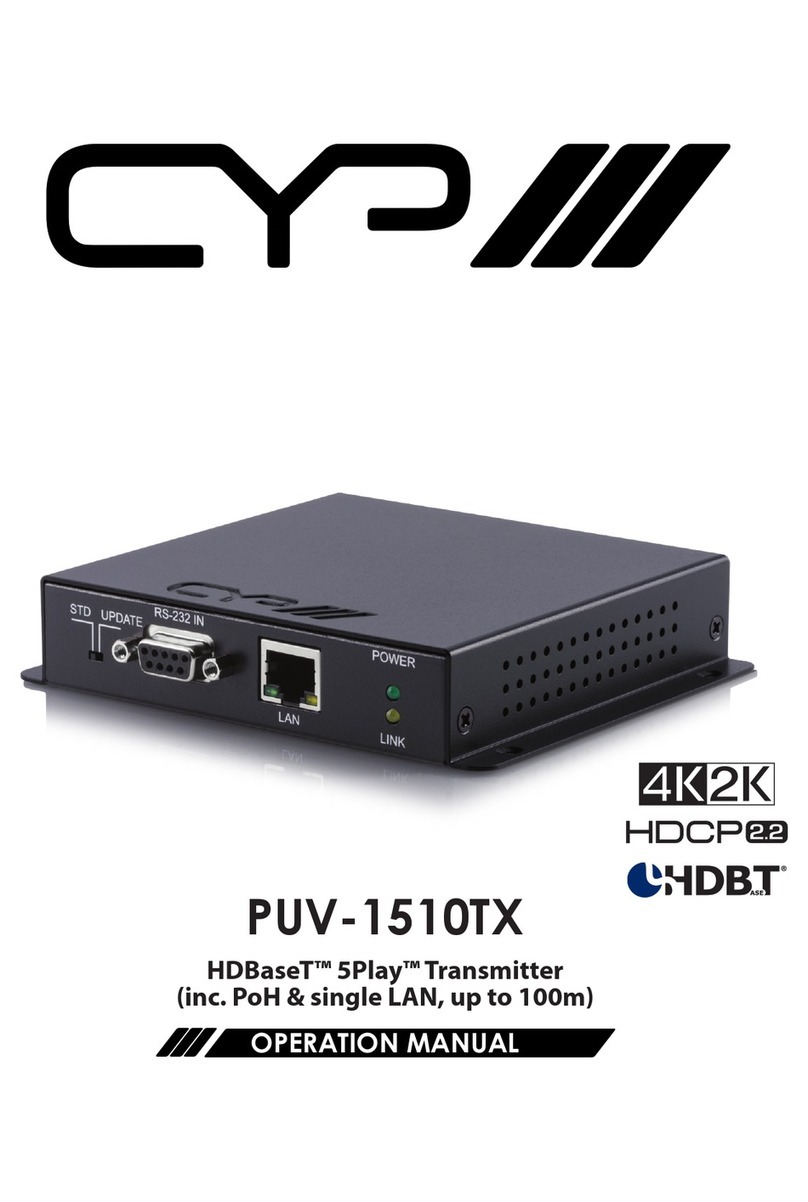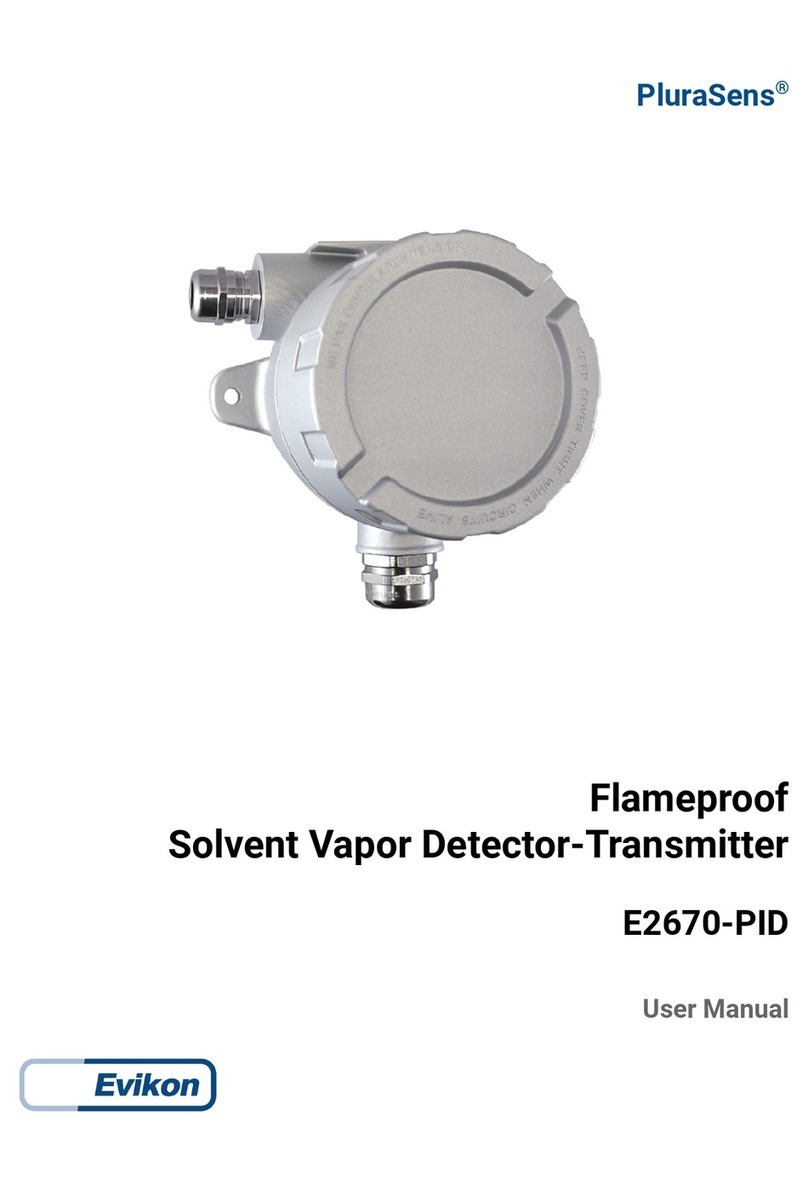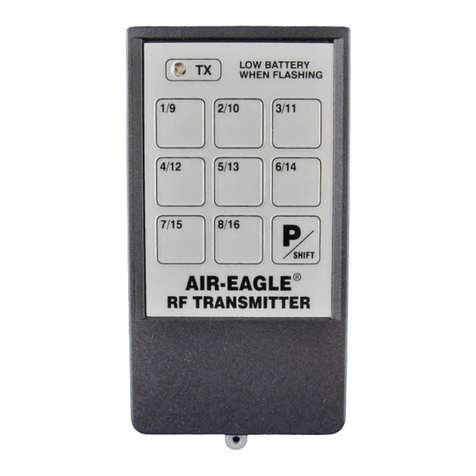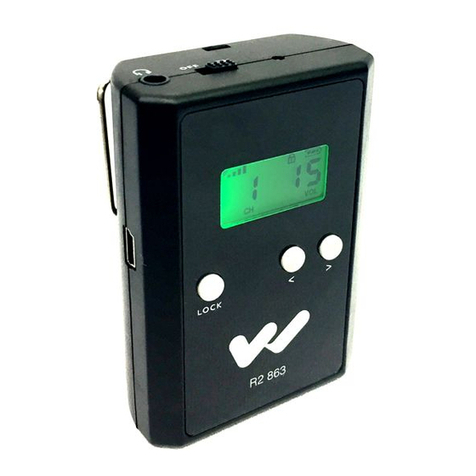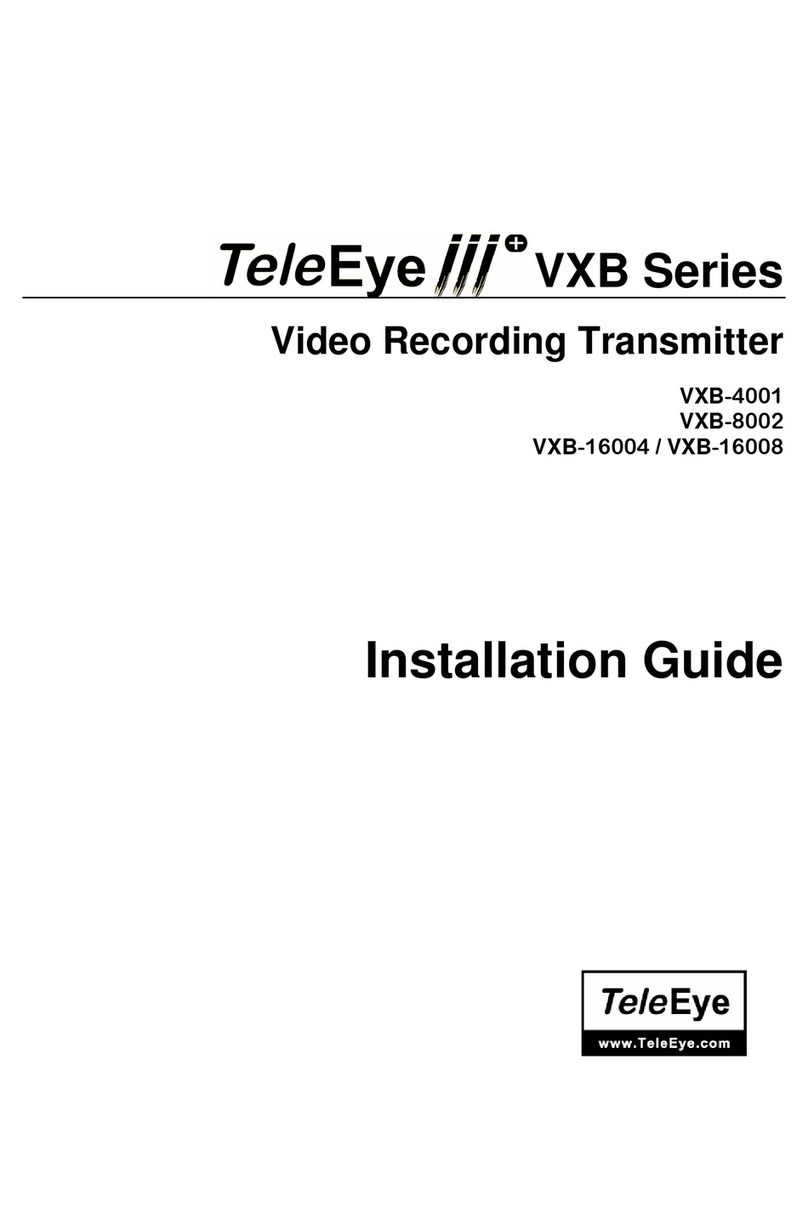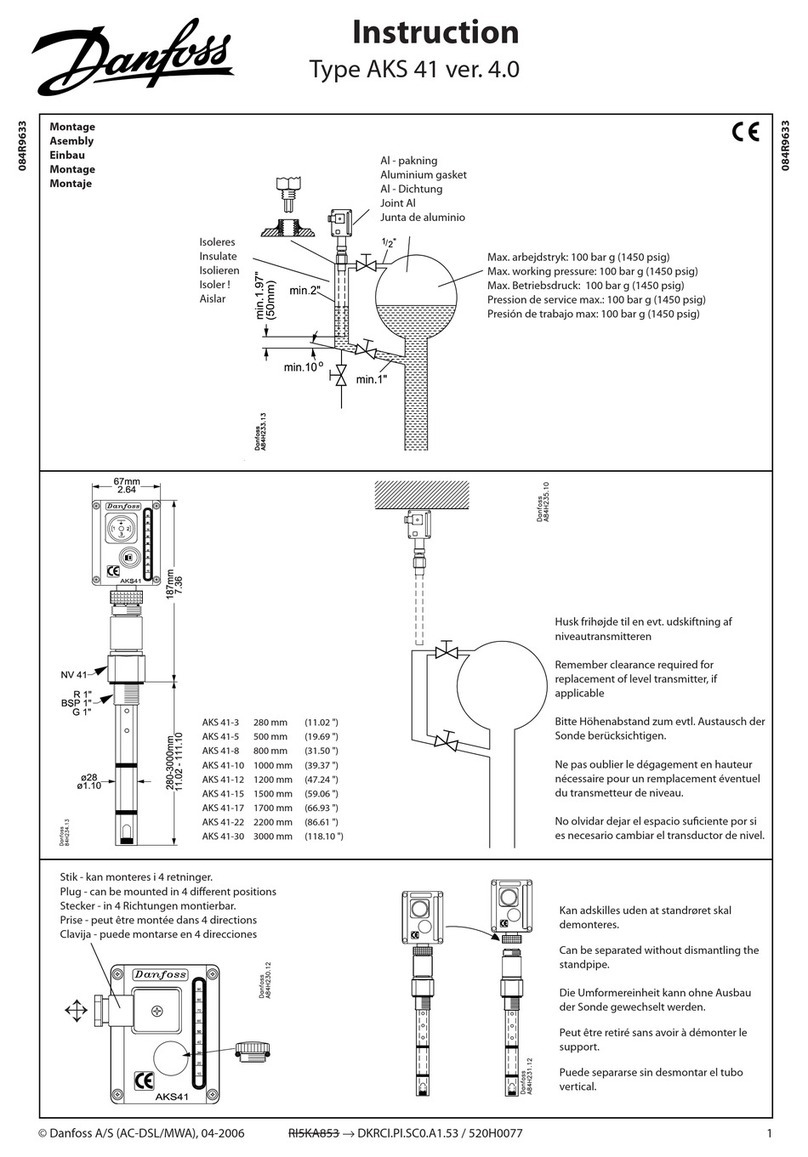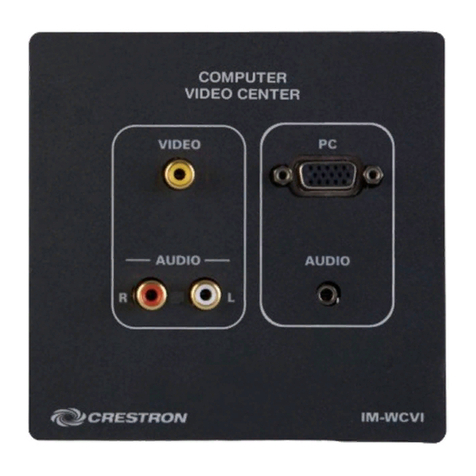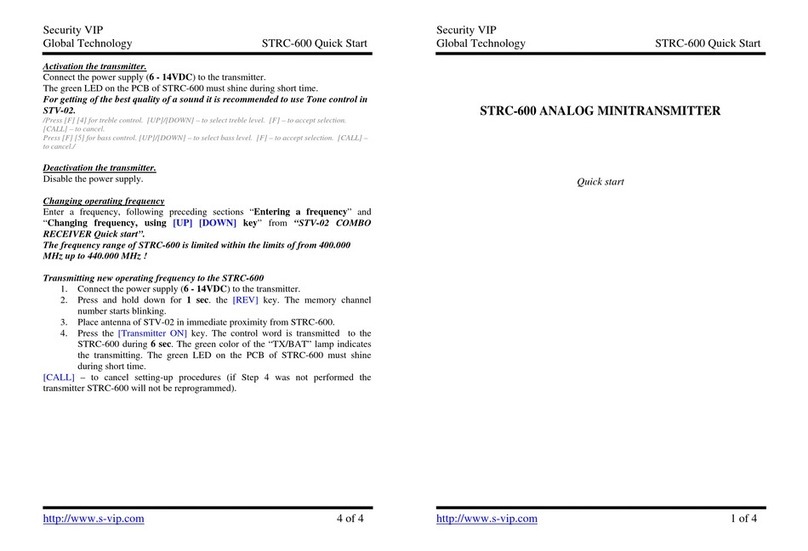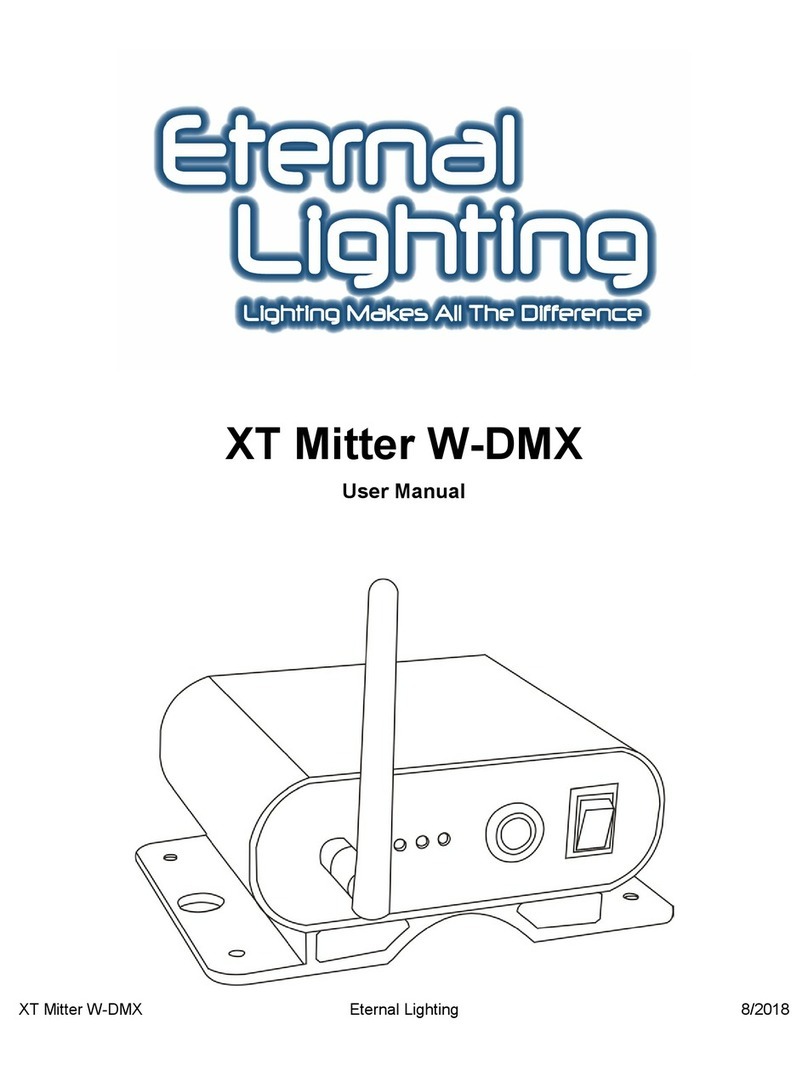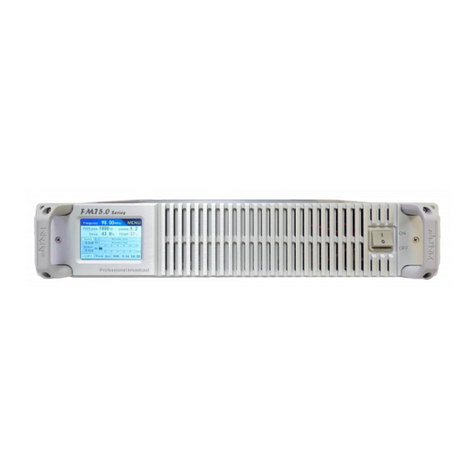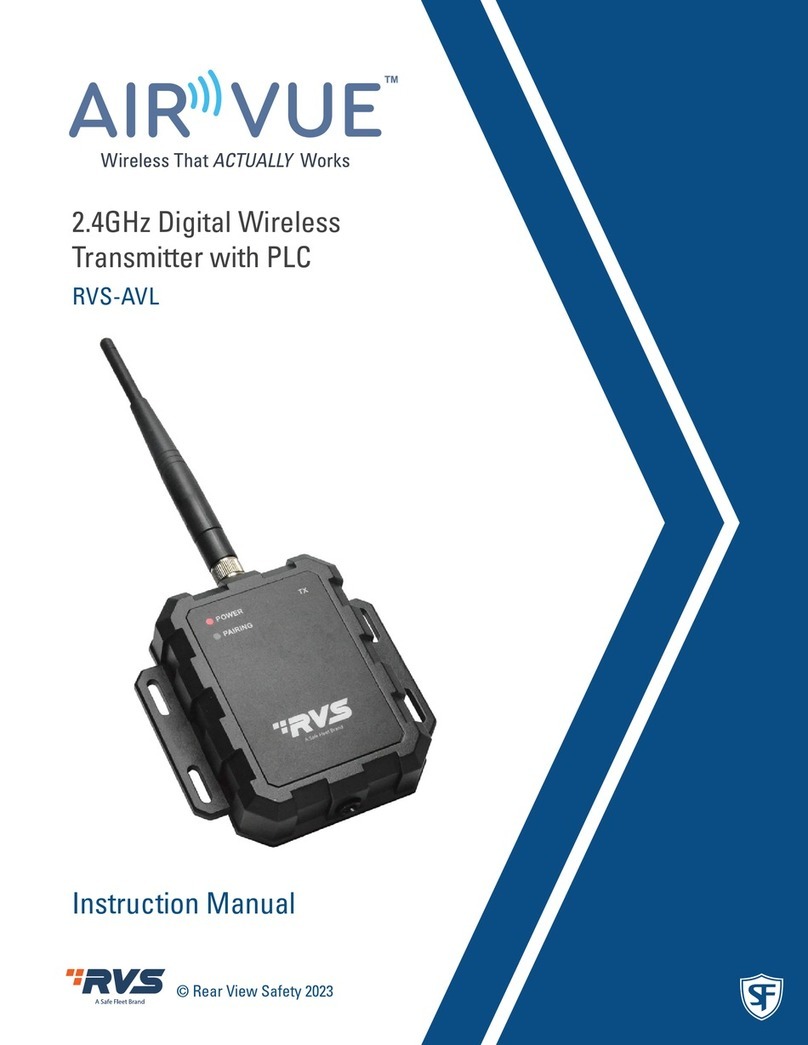Ebyte K61-DL20 User manual

K61-DL20
Switch Value Transmission Module
User Manual

成都亿佰特电子科技有限公司 用户使用手册
Copyright ©2012–2020,成都亿佰特电子科技有限公司
1
Contents
I Introduction ..................................................................................................................................................................4
1.1 Features ............................................................................................................................................................ 4
1.2 1.2 Basic parameters ........................................................................................................................................ 5
1.3 Description of dimensions, interfaces, indicators, etc. .................................................................................... 6
1.3.1 Product Dimensions .............................................................................................................................. 6
1.3.2 Product Interface Description ............................................................................................................... 7
1.3.1 Indicator light description ..................................................................................................................... 9
1.4 Internal circuit structure of the product.........................................................................................................12
1.4.1 The internal principle diagram of the sending (collecting) end product ............................................ 12
1.4.2 The internal principle diagram of the receiving (output) end product ............................................... 12
II. Quick Start ...............................................................................................................................................................13
2.1 List of products and accessories .................................................................................................................... 13
2.2 Quick use ........................................................................................................................................................14
2.2.1 Step 1: Connect the product to the antenna and power ...................................................................... 14
2.2.2 Step 2: Sending (collecting) terminal product signal input wiring .................................................... 14
2.2.3 Step 3: Receive (output) end product signal output wiring ................................................................15
2.2.4 Step 4: Power on the product and observe the status of the indicator lights ......................................16
2.2.5 Step 5: On-site installation ..................................................................................................................16
2.3 Model selection overview .............................................................................................................................. 17
2.3.1 Product model selection table ............................................................................................................. 17
2.3.2 Product model naming rules ............................................................................................................... 19
III. Hardware connection and related knowledge ........................................................................................................20
3.1 Power Hardware Connection ......................................................................................................................... 20
3.1.1 Power supply selection ........................................................................................................................20
3.1.2 Power Connection ............................................................................................................................... 20
3.1.3 Precautions and instructions for power connection ............................................................................20
3.2 Hardware connection of the first communication method ............................................................................ 21
3.2.1 The first communication method: RS485 ...........................................................................................21
3.3 Hardware connection of the second communication method ........................................................................22
3.3.1 The Hardware connection and installation of the second communication method(LoRa spread
spectrum)................................................................................................................................................... 22
3.4 Switch input and output hardware connection ...............................................................................................23
3.4.1 Wet node: NPN normally open/PNP normally closed sensor (DI) wiring method ............................23
3.4.2 Dry Contact: Key Switch (DI) Wiring Method .................................................................................. 23
3.4.3 Wiring method of switch output (DO) ................................................................................................24
IV.Configuration software driver installation, each function parameter reading, description and writing .................25
4.1 Configuration software tools and driver installation ..................................................................................... 25
4.1.1 Configuration software tools and driver installation package download ...........................................25
4.1.2 Configuration software tools and driver installation .......................................................................... 25
4.1.3 Introduction to configuration software tool interface .........................................................................27

Chengdu Ebyte Electronic Technology Co.,Ltd. User Manual
Copyright ©2012–2020,Chengdu Ebyte Electronic Technology Co.,Ltd.
2
4.2 Reading and changing the basic parameters of the product .......................................................................... 28
4.2.1 Product hardware connection and COM port selection ......................................................................28
4.2.2 Reading the basic parameters of the product ......................................................................................29
4.2.3 Serial port parameter change, write and restore default ..................................................................... 30
4.3 I/O configuration Parameter reading, description and writing ......................................................................31
4.3.1 I/O configuration parameter reading ...................................................................................................31
4.3.2 I/O configuration Parameter description ............................................................................................ 31
4.3.3 I/O configuration parameter writing ...................................................................................................33
4.4 Mode configuration Parameter reading, description and writing ..................................................................33
4.4.1 Mode configuration Parameter read ................................................................................................... 31
4.4.2 Mode configuration and parameter description ..................................................................................34
4.4.3 One-to-one configuration write ...........................................................................................................38
4.4.4 One-to-many (with reply) configuration write ................................................................................... 39
4.4.5 One-to-many (no reply) configuration write ...................................................................................... 40
4.4.6 Channel self-organization and configuration write ............................................................................ 42
4.4.7 Transparent transmission of the first communication method: open and write the data remote
transmission function ................................................................................................................................... 45
V.Parameter reading, description and writing of the second communication method ................................................ 46
5.1 The second communication method: LoRa ................................................................................................... 46
5.1.1 LoRa parameter reading ......................................................................................................................46
5.1.2 LoRa parameter description ................................................................................................................46
5.1.3 LoRa parameter configuration writing ............................................................................................... 47
5.1.4 LoRa configuration parameter range .................................................................................................. 48
IV. ModBus ...................................................................................................................................................................48
6.1 ModBus Address Table .................................................................................................................................. 48
6.1.1 Function code and register address table ............................................................................................ 48
6.1.2 Change ModBus address .....................................................................................................................48
6.1.3 Read digital DI input ...........................................................................................................................49
6.1.4 Read switch DO output status .............................................................................................................49
6.1.5 Control switch DO output ...................................................................................................................50
VII. Precautions for use ................................................................................................................................................50
VIII. FAQ ..................................................................................................................................................................... 50
8.1 General question .............................................................................................................................................50
8.1.1 How to test after getting the product? .................................................................................................50
8.1.2 Module power supply requirements ................................................................................................... 51
8.1.3 The RUN light of the module does not light up. ................................................................................ 51
8.1.4 The device cannot be searched by the configuration software ...........................................................51
8.1.5 The communication between the two modules is unsuccessful, But the NET light of two modules
does not light up ........................................................................................................................................... 52
8.1.6 The communication between the two devices is unsuccessful, but the NET light is always on....... 52
8.2 LoRa related questions ...................................................................................................................................52
8.2.1 LoRa communication, what should be paid attention to? .................................................................. 52
8.2.2 LoRa communication, what is the actual communication distance of the 4KM or 8KM module? ...52
8.2.3 How should the antenna be placed ..................................................................................................... 53

Chengdu Ebyte Electronic Technology Co.,Ltd. User Manual
Copyright ©2012–2020,Chengdu Ebyte Electronic Technology Co.,Ltd.
3
8.3 Questions related to digital input and output ................................................................................................. 53
8.3.1 AI/AO input/no input/output, DI/DO input/no input/output .............................................................. 53

Chengdu Ebyte Electronic Technology Co.,Ltd. User Manual
Copyright ©2012–2020,Chengdu Ebyte Electronic Technology Co.,Ltd.
4
I. Product Introduction
1. This product is a cross-communication function product. Function: The sender collects 4-channel switch signal and
transmits the data to the receiver through wireless (LoRa spread spectrum) or network port, and the receiver restores the
4-channel switch signal.
2. Product model K61-Dxx, including sending (collection) end: K61D-40Rxx; receiving (output) end: K61D-04Rxx. (For
more naming details, see the "Product Model Naming" chapter)
Figure 1-1
3. The module also has 485 data transparent transmission function. The 485 data of the sender and receiver can be
transparently transmitted through LoRa wireless communication.
4. The product has a high degree of ease of use, avoids long-distance wiring, greatly reduces the cost of
manpower/material resources, and reduces the difficulty of construction and maintenance.
5. Aimed at industrial users, all-industrial-grade design, after a lot of testing, the quality is stable and reliable.
6. Construction-free installation: It can replace the link cable, and the transmission distance is long, eliminating the
trouble of cable construction.
7. Programming-free design: no programming is required, all parameters can be configured through the host computer
software, which is easy to use and reliable in operation.
8. Automatic error correction: The terminal has strong error correction ability and can actively correct the disturbed data
packets, greatly improving the transmission reliability.
1.1 Features
The sending (collection) end supports 4-channel digital signal input;
The receiving (output) end supports 4-way digital signal output;
It has the function of transparent data transmission between the first communication interface (RS485
(default)/RS232) and the second communication interface (LoRa/ETH network port...);
With hardware watchdog, it has high reliability and recoverability;
It has good protection functions such as overcurrent, overvoltage, anti-reverse connection, and anti-misconnection;
Rich indicator lights, comprehensive view of the status, easy to troubleshoot;
The device has a debounce time of 25ms, which makes the input acquisition signal more stable and reliable and less

Chengdu Ebyte Electronic Technology Co.,Ltd. User Manual
Copyright ©2012–2020,Chengdu Ebyte Electronic Technology Co.,Ltd.
5
susceptible to interference;
The communication channel can be set, and a maximum of 83 channels can be used for data communication in one
area without interfering with each other;
The wireless 433Mhz (LoRa spread spectrum) communication power is 0.1W, the communication distance is 4000
meters (open space), and stable transmission is possible within 500 meters of ordinary scene applications;
Customized functions are supported, please contact sales.
1.2 Basic parameters
Table 1.1 Basic parameters
Category
Item
Description
DI input
DO output
Number of DI/DO
channels
4
Interface Type
Switch (digital) type
Connection method
5.08mm industrial grade plug-in terminal
Refresh rate
When a signal change is detected, trigger immediately (debounce time
150ms).
DI signal input
1. The dry and wet nodes are compatible, and the low-level input of the
switching value is valid;
2. DI acquisition channel and GND: the effective voltage input range of
low-level action is less than 0.7V; the withstand voltage range is less than
30V; reverse connection may cause product damage.
DO signal output
1. The switch output type is: relay normally open contact output;
2. Relay contact load current range: ≤3A.
Physical
characteristics
Product Size
110*84.32*25.3mm(length*width*height)
Product weight
164±5g
Package weight
710±10g
Working
environment
Operating temperature
-40℃~85℃
Storage temperature
-60℃~125℃
Working humidity
5%~95% RH
Storage humidity
1%~95%
Waterproof level
Not waterproof, with certain moisture resistance
Dust rating
Completely blocks dust
Power supply
Operating Voltage
DC voltage: DC 8V~28V
Power connector type
5.08mm industrial grade plug-in terminal
Transmitter power
consumption
Pmax (maximum power consumption) = 1W, Pav (average power
consumption) ≤ 0.5W
Receiver power
consumption
Pmax (maximum power consumption) = 1W, Pav (average power
consumption) ≤ 0.5W
First method
of
Type
RS485
Whether with isolation
No

Chengdu Ebyte Electronic Technology Co.,Ltd. User Manual
Copyright ©2012–2020,Chengdu Ebyte Electronic Technology Co.,Ltd.
6
communicatio
n
Connection method
5.08mm industrial grade plug-in terminal
Second means
of
communicatio
n
Type
LoRa Wireless Spread Spectrum (SX1262)
Transmit power
160mW (22dBm)
Working frequency
410.125~493.125Mhz (default 410.125Mhz)
Measured distance
4000 meters (clear and open environment, maximum power, airspeed 2.4K,
antenna gain 5dBi, feeder length 1m);It is recommended that the actual
engineering application distance should be less than or equal to 1000
meters.
Air rate
2.4~62.5kbps (default 4.8kbps)
Receive sensitivity
-138dbm
Actual frequency
calculation formula
Actual frequency=410.125Mhz+channel*1Mhz
Number of channels
83
Matching Antenna
Interface/Impedance/Fre
quency
SMA female thread inner needle/equivalent impedance 50Ω/433Mhz
1.3 Description of dimensions, interfaces, indicators, etc.
1.3.1 Product Dimensions
Note: 1. The size of the sender and receiver are the same, see the figure below.
2. Figure 1-2 below is the reference size of the product, the error is ±0.3mm, please refer to the actual product.

Chengdu Ebyte Electronic Technology Co.,Ltd. User Manual
Copyright ©2012–2020,Chengdu Ebyte Electronic Technology Co.,Ltd.
7
Figure 1-2 Product Dimensions
1.3.2 Product Interface Description
(1) Interface description of the sending (collecting) end product
Figure 1-3 Display of the product interface on the sending (collecting) end
Table 1.3.2 Definition of Pin Functions of Sending (Acquisition) End Products
No.
Port and Other
Function
Description

Chengdu Ebyte Electronic Technology Co.,Ltd. User Manual
Copyright ©2012–2020,Chengdu Ebyte Electronic Technology Co.,Ltd.
8
Definitions
1
PE
Protective earth
terminal
Lightning protection grounding. If the ground lead is good, it is
recommended to connect the product case to the ground; vice versa.
2
+
Positive power
supply
The power input is positive, and the DC voltage input range is DC
8-28V.
3
-
Power ground
Power input negative (0V).
4
B/RX
Communication
interface B/RXD
RS485 interface B/(RS232_RXD).
5
A/TX
Communication
interface A/TXD
RS485 interface A/(RS232_TXD).
6
G
Communication
port
RS485 ground (can not be connected)/RS232 signal ground (0V).
7
Second
communication
interface
Antenna
port/network port
433Mhz antenna port/network port socket
8
DI1
Switch value
acquisition channel
1
Switch signal acquisition channel 1. With GND: dry contact input is
closed and valid; wet contact is less than 0.7V valid.
9
GND
Input negative
Input negative (0V).
10
DI2
Switch value
acquisition channel
2
Switch signal acquisition channel 2. With GND: dry contact input is
closed and valid; wet contact is less than 0.7V valid.
11
GND
Input negative
Input negative (0V).
12
DI3
Switch value
acquisition channel
3
Switch signal acquisition channel 3. With GND: dry contact input is
closed and valid; wet contact is less than 0.7V valid.
13
GND
Input negative
Input negative (0V).
14
DI4
Switch value
acquisition channel
4
Switch signal acquisition channel 4. With GND: dry contact input is
closed and valid; wet contact is less than 0.7V valid.
15
GND
Input negative
Input negative (0V).
16
None
Leave it in the air, do not connect.
17
SFR
Reset
Press and hold for 3 seconds to restore the factory settings (Set
Factory Reset) (indicated by the status of the RUN light).
18
SIM
SIM card slot
Insert a data IoT card or a phone card with a sufficient data plan.
(This product has no SIM card slot)
(2) Description of the product interface at the receiving (output) end.

Chengdu Ebyte Electronic Technology Co.,Ltd. User Manual
Copyright ©2012–2020,Chengdu Ebyte Electronic Technology Co.,Ltd.
9
Figure 1-4 Display of the product interface on the receiving (output) end
Table 1-4 Definition of pin function of receiving (output) end product
No.
Port and Other
Definitions
Function
Description
1
PE
Protective earth
terminal
Lightning protection grounding. If the ground lead is good, it is
recommended to connect the product case to the ground; vice versa.
2
+
Positive power
supply
The power input is positive, and the DC input voltage range is 8-28V.
3
-
Power ground
Power input negative (0V).
4
B/RX
Communication
interface B/RXD
RS485 interface B/(RS232_RXD).
5
A/TX
Communication
interface A/TXD
RS485 interface A/(RS232_TXD).
6
G
Communication
port
RS485 ground (can not be connected)/RS232 signal ground (0V).
7
Second
communication
interface
Antenna
port/network port
433Mhz antenna port/network port socket
8
NO1
Switch output
channel 1
The relay is normally open contact output, and the contact current is
less than or equal to 3A.
9
COM1
Public 1
Common terminal of relay output channel 1.
10
NO2
Switch output
channel 2
The relay is normally open contact output, and the contact current is
less than or equal to 3A.
11
COM2
Public 2
Common terminal of relay output channel 2.
12
NO3
Switch output
channel 3
The relay is normally open contact output, and the contact current is
less than or equal to 3A.
13
COM3
Public 3
Common terminal of relay output channel 3.

Chengdu Ebyte Electronic Technology Co.,Ltd. User Manual
Copyright ©2012–2020,Chengdu Ebyte Electronic Technology Co.,Ltd.
10
14
NO4
Switch output
channel 4
The relay is normally open contact output, and the contact current is
less than or equal to 3A.
15
COM4
Public 4
Common terminal of relay output channel 4.
16
None
Leave it in the air, do not connect.
17
SFR
Reset
Press and hold for 3 seconds to restore the factory settings (Set
Factory Reset) (indicated by the status of the RUN light).
18
SIM
SIM card slot
Insert a data IoT card and a phone card with a data plan. (This
product has no SIM card slot)
1.3.3 Indicator light description
(1) Send (collection) end LED light indication, as shown in below picture.
Figure 1-5
Table 1-5 Function table of analog input module
No.
Indicator
Name
Description
1
RUN
Flashing for 0.5 seconds: indicates that the product is in normal operation;
after 3 seconds of steady light, it will flash for 0.5 seconds: press and hold
the button for 3 seconds, indicating that the factory reset is successful.
2
NET
Steady on: The second communication interface is connected successfully;
Off: The second communication interface is disconnected.

Chengdu Ebyte Electronic Technology Co.,Ltd. User Manual
Copyright ©2012–2020,Chengdu Ebyte Electronic Technology Co.,Ltd.
11
3
TXD
Blinking: Indicates that the product sends out a data signal.
4
RXD
Blinking: Indicates that the product has received a data signal.
5
DI1
Steady on: The switch value closed/active low level signal input is collected;
Off: No valid digital signal input is collected.
6
DI2
Steady on: The switch value closed/active low level signal input is collected;
Off: No valid digital signal input is collected.
7
DI3
Steady on: The switch value closed/active low level signal input is collected;
Off: No valid digital signal input is collected.
8
DI4
Steady on: The switch value closed/active low level signal input is collected;
Off: No valid digital signal input is collected.
(2) LED light indication on the receiving (output) end, as shown below.
Figure 1-6 Indicator light of analog output module
Table 1-6 Function table of analog output module
No.
Indicator Name
Description
1
RUN
Flashing for 0.5 seconds: indicates that the product is in normal operation;
after 3 seconds of steady light, it will flash for 0.5 seconds: press and hold
the button for 3 seconds, indicating that the factory reset is successful.
2
NET
Steady on: The second communication interface is connected successfully;
Off: The second communication interface is disconnected.

Chengdu Ebyte Electronic Technology Co.,Ltd. User Manual
Copyright ©2012–2020,Chengdu Ebyte Electronic Technology Co.,Ltd.
12
3
TXD
Blinking: Indicates that the product sends out a data signal.
4
RXD
Blinking: Indicates that the product has received a data signal.
5
DO1
Always on: the normally open contact of the relay is active (closed);
Off: The relay normally open contact is normal (open).
6
DO2
Always on: the normally open contact of the relay is active (closed);
Off: The relay normally open contact is normal (open).
7
DO3
Always on: the normally open contact of the relay is active (closed);
Off: The relay normally open contact is normal (open).
8
DO4
Always on: the normally open contact of the relay is active (closed);
Off: The relay normally open contact is normal (open).
1.4 Internal circuit structure of the product
1.4.1 The internal principle diagram of the sending (collecting) end product
Internal principle diagram of analog input product
1.4.2 The internal principle diagram of the receiving (output) end product

Chengdu Ebyte Electronic Technology Co.,Ltd. User Manual
Copyright ©2012–2020,Chengdu Ebyte Electronic Technology Co.,Ltd.
13
Internal schematic diagram of analog output product
II. Quick Start (Users are advised to read this chapter first)
This chapter is an introduction to the quick start of this product. It is recommended that users read this chapter carefully
and operate according to the instructions. There will be a systematic understanding of this product, and users can also
choose the chapters you are interested in to read according to their needs. For specific details and instructions, please
refer to the remaining relevant chapters.

Chengdu Ebyte Electronic Technology Co.,Ltd. User Manual
Copyright ©2012–2020,Chengdu Ebyte Electronic Technology Co.,Ltd.
14
2.1 List of products and accessories
Figure 2-1 The complete set of products including modules and accessories
Table 2-1 The complete set of products includes modules and accessories
Item
Model
Quantity
Switch signal acquisition module
K61D-40RL20
1
Switch signal output module
K61D-04RL20
1
12V/1A adapter power supply
CQ12-120100-CC
2
Power adapter cable
DYX01-A
2
Suction cup antenna (SMA inner thread inner
needle/equivalent impedance 50 Ω/433Mhz/3.5dBi
gain/feeder length 1 meter)
TX433-XPL-100
2
USB to 485 tool
K1T-UR0
1
Slotted screwdriver
2*50mm Flat-blade
screwdriver
1
2.2 Quick use
2.2.1 Step 1: Connect the product to the antenna and power
(1) Connect the antenna and power supply as shown in the figure below.

Chengdu Ebyte Electronic Technology Co.,Ltd. User Manual
Copyright ©2012–2020,Chengdu Ebyte Electronic Technology Co.,Ltd.
15
a. Antenna connection: remove the K61-40 and K61-04 antenna caps, and screw the 433Mhz frequency band "suction
cup antenna" on the product clockwise;
b. Power connection: connect the "red wire" of the "power adapter cable" to the "+" pole of the product, and the "black
wire" to the "-" pole of the product; connect the "12V/1A adapter power supply" to the "power adapter cable" .
Figure 2-2 Connecting the antenna and power
(2) Notes:
a. When wiring, please do not connect the wrong port, so as not to damage the product! !
b. For the RF antennas of the transmission pair, it is necessary to be as open as possible and to be able to see directly; the
RF antennas should be as far away as possible: walls, metal shields, big trees, hills, large buildings, etc.
c. The top of the radio frequency antenna should not be attached to objects that have a great attenuation effect on radio
frequency, such as metal and walls, so as not to affect the transmission of radio frequency signals.
d. The distance between the RF antennas of the product is preferably 1 meter or more. If the high-power RF product is
too close to the RF antenna, the receiver cannot receive data. (For more details, see the Frequently Asked Questions and
Solutions (FAQ) section)
2.2.2 Step 2: Sending (collecting) terminal product signal input wiring
(1) Connect a switch (or sensor, etc.) to the DI and GND interfaces of the K61-40 acquisition end of this product as
shown in Figure 2-3 below. Then, after tightening the screw on the plug-in terminal of this product, close the switch (or
let the sensor output a closed switch signal). When the switch is closed, the corresponding IO light is always on,
indicating that the switch closed signal is collected.
(2) Notes:
a. When the input voltage is applied, below 0.7V belongs to the closed state (effective state and the switch signal is
closed), and above 0.7V belongs to the open state (invalid state and the switch signal is disconnected).
b. When the communication between the K61-40 device and the K61-04 device is successfully established, the "NET"
light is on;
c. When the switch signal is collected, the corresponding IO light is always on. If the IO light is not on, please check
whether the sensor outputs a closed switch signal normally;
d. When the terminal is connected to the wire, please tighten the screw on the plug-in terminal of this product, and pay
attention that the conductive part of the terminal cannot be pressed against the insulation layer of the wire, so as to avoid

Chengdu Ebyte Electronic Technology Co.,Ltd. User Manual
Copyright ©2012–2020,Chengdu Ebyte Electronic Technology Co.,Ltd.
16
poor contact and cause abnormality.
(For more details, see the "FAQ" section)
2.2.3 Step 3: Receive (output) end product signal output wiring
(1) According to the figure 2-3 below, connect the DO and GND wires of the output end of K61-04 of this product
according to the figure below (or connect them to the switch signal acquisition sensor). After receiving the switch signal
sent by the sender, the K61-04 device will output a closed switch signal, the light bulb in the picture will be on, and the
corresponding IO light will be always on.
(2) Notes:
a. The output of this product is a switch signal, and it will not output voltage;
b. When the devices are powered on (sending and receiving), check the "NET" light of the K61-04 device, if the "NET"
light is on, the communication between the two devices is successfully established;
c. When the corresponding IO light is on, it means that the K61-40 sender receives a switch signal, and the K61-04
output terminal outputs a closed switch signal:
d. When the terminal is connected to the wire, please tighten the screw on the plug-in terminal of this product, and pay
attention that the conductive part of the terminal cannot be pressed against the insulation layer of the wire, so as to avoid
poor contact.
(For more details, see the "FAQ" section)
Figure 2-3 Connecting IO ports
2.2.4 Step 4: Power on the product and observe the status of the indicator
lights
(1) Plug the two 12V/1A adapters into the power strip (mains AC220V), and the entire system is powered on.
(2) Observe the status of the indicator light, the sending end collects the digital signal and the receiving end outputs the

Chengdu Ebyte Electronic Technology Co.,Ltd. User Manual
Copyright ©2012–2020,Chengdu Ebyte Electronic Technology Co.,Ltd.
17
digital signal, as shown in Figure 2-4.
a. The RUN light flashes once every 0.5 seconds, indicating that the product is powered on successfully;
b. When the NET light of the supporting product is on, it means that the wireless communication between the two
modules is successful;
c. The DI light is on, indicating that the acquisition signal is successful; the DO light is on, indicating that the output
signal is successful;
(3) Notes:
a. For more details on the functions of the indicator lights, see the chapter "Indicator Description";
b. If the NET indicator does not light up, it means that the wireless communication is unsuccessful. It is necessary to
check whether the antennas of the product are installed correctly, ensure that the distance between the antennas is 1 meter
or more, and that there is no obstruction between the antennas of the product.
2.2.5 Step 5: On-site installation
(1) Important knowledge points: The necessary conditions for communication between LoRa wireless spread spectrum
technology paired products: channel, address, and airspeed. Products with the same three parameters can perform data
communication. Conversely, if the parameters are different, data communication cannot be performed. (That is, the LoRa
channel of the transmitter module is the same as the LoRa channel of the receiver module, the LoRa address of the
transmitter module is the same as the LoRa address of the receiver module, and the LoRa wireless airspeed of the
transmitter module is the same as the LoRa wireless airspeed of the receiver module. )
(2) Default parameters: For the default parameter properties of this product, see the nameplate label on the back of the
product for details.
(3) Key point: It is recommended that users configure, record and manage the LoRa wireless spread spectrum channel,
address, and airspeed of the paired product when using this product in engineering.
Reason: to avoid data conflicts between the same type of products in engineering applications and the field environment;
in addition, to avoid forgetting the three parameters of the installed equipment when adding this product next time, which
leads to have to read the parameters on site, causing unnecessary Trouble.
(4) Configuration operation details: For details of LoRa wireless parameter configuration method, please refer to "Driver
and Configuration Software Tool Installation", and the configuration software interface is shown in Figure 2-5 below.

Chengdu Ebyte Electronic Technology Co.,Ltd. User Manual
Copyright ©2012–2020,Chengdu Ebyte Electronic Technology Co.,Ltd.
18
Figure 2-5 Screenshot of configuration software
2.3 Model selection overview
2.3.1 Product model selection table
Model
Description
K41-DG
1-way switch bidirectional 4G remote transmission. It is used in the case of long distance and 4G
signal
K41-DL20
1-way switch value two-way 433M wireless remote transmission, open communication
transmission distance 4KM
K41-DL30
1-way switch value two-way 433M wireless remote transmission, open communication
transmission distance 8KM
K42-DG
2-way 0/4~20mA analog one-way 4G remote transmission. It is used in the case of long distance
and 4G signal
K42-DL20
2-way 0/4 ~20mA analog one-way 433M wireless remote transmission, open communication
transmission distance 4KM
K42-DL30
2-way 0/4 ~20mA analog one-way 433M wireless remote transmission, open communication
transmission distance 8KM
K43-DG
1-way 0/4~20mA analog quantity and 1-way switch quantity one-way 4G remote transmission. It
is used in the case of long distance and 4G signal
K43-DL20
1 channel 0/4~20mA analog quantity and 1 channel switch value one-way 433M wireless remote
transmission, open communication transmission distance 8KM
K43-DL30
4-way switch value unidirectional Ethernet (LAN) remote transmission. It is used for the situation
that two network ports in the LAN can ping through
K61-DE
4-way switch value one-way Ethernet (Internet) remote transmission. Used in different places, as
long as there is a network port that can access the Internet

Chengdu Ebyte Electronic Technology Co.,Ltd. User Manual
Copyright ©2012–2020,Chengdu Ebyte Electronic Technology Co.,Ltd.
19
K61-DEW
1 channel 0/4~20mA analog quantity and 1 channel switch value one-way 433M wireless remote
transmission, open communication transmission distance 8KM
K61-DL20
4-way switch value one-way 433M wireless remote transmission, open communication
transmission distance 4KM
K62-DE
4-way 0/4~20mA analog Ethernet (LAN) remote transmission. It is used for the situation that two
network ports in the LAN can ping through
K62-DEW
4-way 0/4 ~20mA analog Ethernet (Internet) remote transmission. Used in different places, as
long as there is a network port that can access the Internet
K62-DL20
4 channels 0/4~20mA analog quantity 433M wireless remote transmission, open communication
transmission distance 4KM
K71-DG
8-way switch one-way 4G wireless remote transmission. It is used for application scenarios with
long distances and 4G signals
K71-DL30
8-way switch value one-way 433M wireless remote transmission, open communication
transmission distance 8KM
K72-DG
6 channels of 0/4 ~20mA analog 4G wireless remote transmission. It is used for application
scenarios with long distances and 4G signals
K72-DL30
6 channels 0/4~20mA analog quantity 433M wireless remote transmission, open communication
transmission distance 8KM
......
(For more details, please log in to the official website to check the product model and download the relevant user
manual)
Table of contents
Other Ebyte Transmitter manuals

